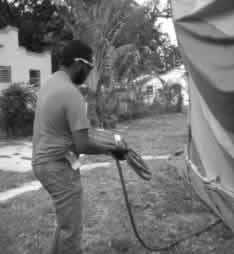Worker Health Study Summaries
On This Page
Research on long-term exposure
Structural Fumigators (methyl bromide/sulfuryl fluoride)
2001
Study Background
In 1992-1993, NIOSH conducted a study about how methyl bromide and sulfuryl fluoride (Vikane®) affects workers. These fumigants are used to kill termites in buildings.

What We Learned about the Health Effects of Methyl-Bromide and Sulfural fluoride (Vikane®)
We found small differences in performance on 2 tests of the nervous system, among the men who worked with the fumigant, sulfuryl fluoride (Vikane®), compared to non exposed workers.
Among the tent crew workers, the small differences we found in 2 other tests may have been due to stresses caused by handling heavy tarps and spring clamps.
The NIOSH study found no negative health effects on the kidneys or the lungs. In 1992-1993, you helped us by taking part in a NIOSH study about how methyl bromide and sulfuryl fluoride Vikane®) affects workers. These fumigants are used to kill termites in buildings. This booklet tells you what we found overall about the health effects of the fumigants we studied.
What Other Studies Suggested
Other studies have found that breathing in high amounts of methyl bromide and sulfuryl fluoride (Vikane®) harms the nervous system. Some studies suggested that working with small amounts of methyl bromide for many years may reduce memory. Those studies also found that persons who worked with Vikane® for many years did not score as well on some tests of the nervous system as did workers who never worked with the sulfuryl fluoride.
Why We did the Study
We wanted to see if working with methyl bromide and Vikane® for a long time harms the health of workers.
We wanted to see if working with these fumigants harms the nervous system, the kidneys, or the lungs).
How We did the Study
In 1992 and 1993, we tested the nervous system of 2 groups of workers. One group worked as shooters or tent crew workers. We call the shooters and tent crew workers the “exposed group”.
The other group was about the same age and was made up of friends or neighbors of the exposed workers. These men said that they had not worked with fumigants. The men in this group also said that they had not worked with nor been poisoned by pesticides. We call this group the “non-exposed group”.
Performance Tests
We did several different tests of the nervous system. Some of the tests measured the following:
- ability to feel sensations in your arms, legs, hands, and feet
- hand-eye coordination
- ability to quickly react to various stimuli
- ability to identify different smells
- ability to control your balance without falling
- ability to use your fingers to move around small objects
- ability to remember patterns
The remaining tests looked at the “genotoxicity” of methyl bromide, or its ability to damage DNA (the part of the cell which carries the traits passed along to you from your parents, and which also tells other parts of the cell what to do). We looked at genetic mutation in lymphocytes HPRT and micronuclei) and in cells from the back of the mouth micronuclei). Everyone has some cells with HPRT damage, which can result from everyday exposures.
Here is What We Found
For most tests, we found no differences in performance between the exposed group and the non-exposed group. For the following 4 tests, the men who worked mainly with Vikane® during the prior year had lower test scores than workers in the non exposed group:
- remembering patterns
- using the main hand (the hand you prefer to use for most tasks) to turn small pegs on a pegboard
- identifying differences in smells
- identifying the speed at which an electrical impulse traveled down a nerve in your lower arm
For the smaller number of men who worked mainly with methyl bromide, there were no differences in their test scores compared to the men who had not worked with pesticides.
Exposed workers also may have been more likely to have carpel tunnel syndrome (CTS) than the non-exposed group. CTS is caused by compression of a nerve in the wrist. It can cause pain and numbness in the affected hand. We do not think the CTS was caused by the fumigants. But we believe that the increase in CTS may be related to handling clamps and heavy tarps.
The genetic tests suggested that workers exposed to methyl bromide had slightly higher levels of genetic mutation. However, no statistically significant differences were found in any tests of the nervous system for the group exposed to methyl bromide as compared to the non-exposed group.
Conclusions

For most tests of the nervous system, we found no differences between the group exposed to Vikane® and the non-exposed group. However, for the tests which showed differences, we believe that the lower test scores among the exposed workers are not likely to affect their day-to day ability to function.
The study suggested that workers exposed to methyl bromide had slightly higher levels of genetic mutation. NIOSH considers the genetic mutation tests to be experimental in that there is no adequately demonstrated direct relationship between the results and your health.
For more information or if you want copies of the study reports, call 800-356-4674 between 9:00 a.m. and 4:00 p.m. Monday through Friday, Eastern time.
NIOSH Publications
4676 Columbia Parkway
Cincinnati, OH
45226-1996
Fax: 513-533-8573
Email: pubstaft@cdc.gov
Web site: www.cdc.gov/niosh
Additional Resources
Calvert G, Mueller C, Fajen J et al. (1998). Health effects associated with sulfuryl fluoride and methyl bromide exposure among structural fumigation workers. American Journal Public Health. 88 (12) 1774-1780. (Study Report)
Calvert G, Talaska G, Mueller C et al. (1998). Genotoxicity in workers exposed to methyl bromide. Mutation Research 417, 115-128.(Study Report)
Noticias Sobre el Estudio de Fumigantes de NIOSH
Durante 1992 y 1993, usted no ayudó con su participación en un estudio de NIOSH realizado para ver como el bromuro de metilo y el fluoruro de sulforilo (Vikane®) afectan a los trabajadores. Estos fumigantes se usan para exterminar termitas en los edificios. Hace algún tiempo le enviamos los resultados de sus pruebas.
En este folleto se le explica todo lo que encontramos sobre los efectos en la salud de los fumigantes que estudiamos.
Lo que usted nos ayudó a conocer sobre los efectos en la salud del bromuro de metilo y fluoruro de Sulforilo (Vikane®) : Encontramos pequeñas diferencias en el desempeño de dos pruebas para el sistema nervioso, entre los hombres que trabajaban con el fumigante fluoruro de sulforilo (Vikane®), comparado con los trabajadores no expuestos.
Las pequeñas diferencias que encontramos en las otras dos pruebas, entre los trabajadores que confinaban las áreas de fumigación, pudieron ser debidas al estrés causado por el manejo de cubiertas pesadas y grapas de tensión.
El estudio de NIOSH no encontró efectos negativos para la salud en los ríñones o en los pulmones.
En otros estudios se ha encontrado que la inhalación de grandes cantidades de bromuro de metilo y fluoruro de sulforilo (Vikane®) causa daño al sistema nervioso. Algunos estudios sugerían que trabajar con pequeñas cantidades de bromuro de metilo durante varios años puede reducir la memoria. En esos estudios también se encontró que las personas que trabajaron con Vikane® por varios años no tenían un desempeño tan bueno en algunas pruebas del sistema nervioso como los trabajadores que nunca trabajaron con el fluoruro de sulforilo.
Porqué realizamos el estudio
- Queríamos ver si trabajar con bromuro de metilo y (Vikane®) por un tiempo prolongado afectaba la salud de los trabajadores
- Queríamos ver si trabajar con estos fumigantes causaba daño al sistema nervioso, los ríñones o los pulmones
Cómo realizamos el estudio
En 1992 y 1993, sometimos a pruebas del sistema nervioso a dos grupos de trabajadores. Uno de los grupos trabajaba como aplicadores o como trabajadores del dedicados a cubrir las áreas de fumigación. A los aplicadores y trabajadores que cubrían las zonas de fumigación les llamamos “grupo expuesto”.
El otro grupo tenía aproximadamente la misma edad y estaba formado de amigos o vecinos de los trabajadores expuestos. Estos hombres aseguraron que no habían trabajado con fumigantes. También, estas personas dijeron que no habían sufrido intoxicación por plaguicidas. Nosotros llamamos a este grupo el “grupo no expuesto”.
Pruebas de desempeño
Llevamos a cabo diferentes pruebas de su sistema nerviso. Algunas de las pruebas midieron lo siguiente:
- Su capacidad para percibir sensaciones en los brazos, piernas, manos y pies
- Su coordinación manual-visual
- Su capacidad para reaccionar rápidamente a varios estímulos
- Su capacidad para identificar varios olores
- Su capacidad para controlar el equilibrio sin caer
- Su capacidad de usar los dedos para mover pequeños objetos
- Su capacidad para recordar patrones
El resto de las pruebas se realizaron para observar la “genotoxicidad” del bromuro de metilo, esto es, su capacidad para producir daño al DNA (la parte de la célula en donde se encuentran las características que se adquieren de sus padres, y que también le dice a otras partes de la célula lo que tienen que hacer). Analizamos la mutación genética en los linfocitos (HPRT y micronúcleos) y en células del interior de la boca (micronúcleos). Todos los participantes en el estudio tienen algunas células con daño del HPRT, que puede ser causado por las exposiciones diarias.
Esto es lo que encontramos
En la mayoría de las pruebas no encontramos diferencias en el desempeño entre el grupo expuesto y el grupo no expuesto.
1. En las cuatro pruebas que se describen a continuación, los hombres que trabajaron con Vikane® durante el año anterior tuvieron puntuaciones más bajas que los trabajadores del grupo no expuesto.
- patrones de memorización
- uso de la mano principal (la mano que usted prefiere usar en la mayoría de las tareas) para mover pequeños sujetadores sobre una plataforma
- identificar diferentes olores
- la velocidad de propagación de un impulso nervioso en un nervio de su antebrazo
En el reducido número de hombres que trabajaron con bromuro de metilo, no hubo diferencias en el desempeño de las pruebas comparados con los hombres que no habían trabajado con plaguicidas.
2. Los trabajadores expuestos también pueden haber tenido mayor probabilidad de tener síndrome de túnel carpiano ( o CTS, como se abrevia en inglés) que el grupo no expuesto. El CTS es causado por compresión de un nervio de la muñeca. Puede causar dolor y entumecimiento de la mano afectada. No creemos que el CTS haya sido causado por lo fumigantes. Pero creemos que el incremento en el CTS puede estar relacionado con el manejo de grapas de presión y cubiertas pesadas.
Conclusiones
En la mayoría de las pruebas del sistema nervioso, no encontramos diferencias entre el grupo expuesto a (Vikane®) y el grupo no expuesto. Sin embargo, en las pruebas que mostraron diferencias, creemos que es poco probable que las puntuaciones más bajas entre los trabajadores expuestos afecten el desempeño de sus capacidades diarias.
Nuestro estudio sugirió que los trabajadores expuestos al bromuro de metilo tuvieron niveles ligeramente elevados de mutaciones genéticas.
NIOSH considera que estas pruebas son de carácter experimental ya que no se ha demostrado en forma adecuada una relación directa entre los resultados y su salud.
Gracias por participar en nuestro estudio.
Para mayor información o si usted desea copias de los reportes del estudio, por favor llame al teléfono 800-356-4674 de 9:00 AM a 4:00 PM de lunes a viernes, tiempo del Este
NIOSH Publications
4676 Columbia Parkway
Cincinnati, OH 45226-1996
Fax: 513-533-8573 – Email: pubstaft@cdc.gov
- Page last reviewed: April 11, 2017
- Page last updated: July 13, 2012
- Content source:
- National Institute for Occupational Safety and Health (NIOSH) Division of Surveillance, Hazard Evaluations, and Field Studies.


 ShareCompartir
ShareCompartir